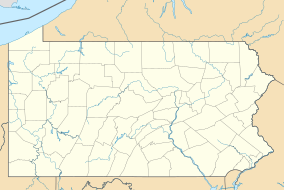| Bald Eagle State Forest | |
|---|---|
 Bald Eagle State Forest vista from Pine Swamp Road in Centre County | |
Location of Bald Eagle State Forest's headquarters in Pennsylvania | |
| Location | Pennsylvania, U.S. |
| Coordinates | 40°53′16″N 77°39′22″W / 40.88778°N 77.65611°W |
| Area | 194,602 acres (787.53 km2) |
| Elevation | 1,788 ft (545 m) |
| Governing body | Pennsylvania Department of Conservation and Natural Resources |
| Website | https://www.dcnr.pa.gov/StateForests/FindAForest/BaldEagle/Pages/default.aspx |
Bald Eagle State Forest is a Pennsylvania state forest in Pennsylvania Bureau of Forestry District #7. The main office is located in Laurelton in Union County, Pennsylvania. The forest is found in Centre, Clinton, Mifflin, Snyder, and Union Counties. Bald Eagle shares a common border on its western extent with Rothrock State Forest and on its northern extent with Tiadaghton State Forest.
Five Pennsylvania State Parks are contained within the forest: Poe Valley, Poe Paddy, R. B. Winter, Reeds Gap, and Sand Bridge, as well as two former state parks: Snyder-Middleswarth Natural Area (formerly Snyder-Middleswarth State Park) and Hairy Johns Picnic Area (formerly a state park known as both "Hairy John's State Forest Park" and "Voneida State Forest Park").
YouTube Encyclopedic
-
1/1Views:951
-
Bald Eagle State Forest
Transcription
History
Bald Eagle State Forest was formed as a direct result of the depletion of the forests of Pennsylvania that took place during the mid-to-late 19th century. Conservationists like Dr. Joseph Rothrock became concerned that the forests would not regrow if they were not managed properly. Lumber and Iron companies had harvested the old-growth forests for various reasons. They clear cut the forests and left behind nothing but dried tree tops and rotting stumps.
The sparks of passing steam locomotives ignited wildfires that prevented the formation of second growth forests. The conservationists feared that the forest would never regrow if there was not a change in the philosophy of forest management. They called for the state to purchase land from the lumber and iron companies and the lumber and iron companies were more than willing to sell their land since that had depleted the natural resources of the forests.[1]
The changes began to take place in 1895 when Dr. Rothrock was appointed the first commissioner of the Pennsylvania Department of Forests and Waters, the forerunner of today's Pennsylvania Department of Conservation and Natural Resources. The Pennsylvania General Assembly passed a piece of legislation in 1897 that authorized the purchase of "unseated lands for forest reservations." This was the beginning of the State Forest system.[1]
Recreation
The forest offers a wide variety of recreational activities.[2]
- Hiking
- Mountain Biking
- Picnicking
- Fishing
- Hunting
- Camping
- Horseback Riding
- Cross Country Skiing
- ATV Riding
- Snowmobiling
Horse riding
Horses may be ridden on most of the forest's shared-use trails, which exceed 300 miles, and the state forest roads. Horses are not permitted on the Mid State Trail (MST), District hiking trails (yellow blaze), or in Natural Areas. Trails range from easy to very difficult, and some may not be suitable due to difficult terrain. The forest features the Central Mountains Shared Use Trail, a network of 120 miles of trails for hiking, biking, and horses. Several motorized campsites in the forest are suited to camping with horses.[3]
Events
Various events are held in Bald Eagle each year including the Wilderness 101, a 101-mile (163 km) mountain bike race.
Neighboring state forest districts
- Tiadaghton State Forest (north)
- Weiser State Forest (east)
- Tuscarora State Forest (south)
- Rothrock State Forest (southwest)
- Sproul State Forest (northwest)
Other attractions

Hiking
Natural areas
- Joyce Kilmer Natural Area; 77 acres (31 ha)
- The Hook Natural Area; 5,119 acres (2,072 ha)
- Mt. Logan Natural Area; 512 acres (207 ha)
- Rosecrans Bog Natural Area; 152 acres (62 ha)
- Snyder Middleswarth Natural Area; 500 acres (202 ha)
- Tall Timbers Natural Area; 660 acres (267 ha)
Wild areas
- White Mountain Wild Area; 3,581 acres (1,449 ha)
References
- ^ a b "History of the William Penn State Forest". Pennsylvania Department of Conservation and Natural Resources. Archived from the original on 2007-08-23. Retrieved 2007-08-29.
- ^ "Bald Eagle State Forest". Pennsylvania Department of Conservation & Natural Resources. Retrieved 2023-07-09.
- ^ "Horseback Riding in Bald Eagle State Forest". Pennsylvania Department of Conservation & Natural Resources. Retrieved 2023-07-09.
- "Bald Eagle State Forest". Pennsylvania Department of Conservation and Natural Resources. Archived from the original on September 23, 2015. Retrieved 2006-07-12. Note: As of July 2006, this web page has not been updated to reflect the Pennsylvania State Forest Districts realignment.
- "State Forest Districts". Pennsylvania Department of Conservation and Natural Resources. Archived from the original on 2006-05-15. Retrieved 2006-07-12. Note: Map showing districts after the July 1, 2005 realignment
- "2007 General Highway Map Centre County Pennsylvania" (PDF). Pennsylvania Department of Transportation. Retrieved 2007-09-10.[permanent dead link] Note: shows Bald Eagle State Forest
- "2007 General Highway Map Clinton County Pennsylvania" (PDF). Pennsylvania Department of Transportation. Retrieved 2007-09-10.[permanent dead link] Note: shows Bald Eagle State Forest
- "2007 General Highway Map Snyder County and Union County Pennsylvania" (PDF). Pennsylvania Department of Transportation. Retrieved 2007-09-10.[permanent dead link] Note: shows Bald Eagle State Forest
- "2007 General Highway Map Juniata County and Mifflin County Pennsylvania" (PDF). Pennsylvania Department of Transportation. Retrieved 2007-09-10.[permanent dead link] Note: shows Bald Eagle State Forest


